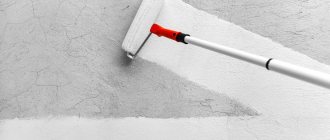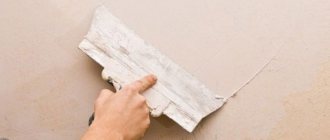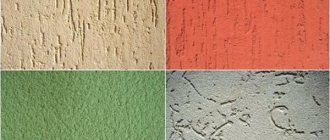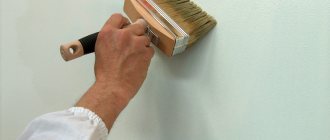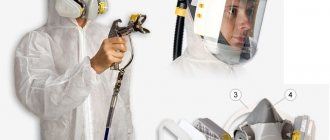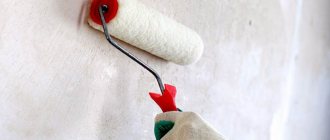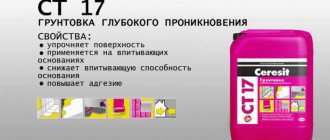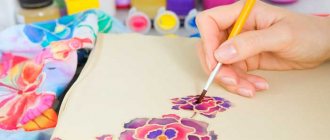Stage 1 – prepare everything you need
A roller suitable for painting fiberboard
To perform the work efficiently, first of all, we will prepare the necessary tools. We will need:
- a roller, preferably with a surface covered with a fur coat rather than foam rubber;
- a brush, since you often have to paint in inconvenient places;
- paint tray;
- spatula for applying sealants;
- a vacuum cleaner, with which we will thoroughly clean the surface after sanding the treated joints.
After preparing the tool, you can proceed directly to work. Before painting the fiberboard, you will have to carry out preparatory work, because the final result depends on this.
Dyeing technology
The technology for painting fiber board is no different from painting any other materials. The process is carried out in several stages:
- collection of tools;
- surface preparation for painting;
- choice of paint;
- direct painting;
- application of a protective coating.
Required Tools
To paint a fiberboard floor you need to prepare:
- a fur roller (foam rubber is not suitable for these purposes);
- paint brush;
- paint tray;
- rag;
- vacuum cleaner.
Next, the preparatory stage begins.
Surface preparation
It is imperative to take into account an important nuance - before performing any work with fiberboards, the fiberboard is first brought to a certain humidity. Otherwise, over time, the slab will move in waves, thereby ruining the floor or wall. Moistening fiberboard is simple: moisten the back side of the sheet with warm water, and then fold the sheets in pairs. The slabs should be left to dry for a day.
Floors are often made from fiberboard. In order for a fiberboard floor to boast the same service life as a wooden base, it is important to properly treat it, including painting. A hardboard floor is very porous - any paint will be absorbed there in a significant amount than into a concrete or wooden floor.
Experts first suggest covering the surface with a primer - if this is not done, then a positive result can be achieved, but the paint consumption will be very large.
Paint for fiberboard should be applied only to the glossy side of the sheet - the other side is not suitable for this. On the other side, a primer is more appropriate. Due to the peculiarities of its manufacturing and structure, the slab is capable of absorbing 4 times more paint, and applying a primer is one of the stages before painting.
Primer materials are now widely represented on the construction market. Fiberboard and hardboard are traditionally treated with drying oil - this is an affordable and practical product. But the drying oil should be heated to 40 degrees.
Before applying the primer, the slabs are thoroughly cleaned of dust. This can be done either with an ordinary rag or with a vacuum cleaner. The cracks in the floor are sealed with tape or reinforced tape. The entire remaining surface must be degreased - you can use a solvent or alcohol.
The primer is applied with a roller. Experts recommend applying several layers. When the slab is impregnated with drying oil in three layers, the resistance of the material to moisture significantly increases. To increase the service life of hardboard, it is necessary to process it after the cutting is done, but before the laying process.
Paint selection
Painting of fiberboard is carried out using any coloring enamels, but it is better to choose super-hard types of paints. They are marked “ST”. It is these dyes that will give the floor maximum resistance to wear. Oil and alkyd paints are used as alternatives.
Water-based paints are not suitable in this case - they will not be able to adhere to the fiberboard coating. The slab contains paraffin - it will repel paint.
You can also use decorative varnish instead of paint. There are also some tricks with which you can create unusual color schemes. So, to imitate natural wood, you can apply liquid bitumen varnish to the surface with a brush. To create a paint with a “plastic surface” effect, glossy compounds are used.
Painting process
For painting work, experts do not recommend using foam sponges or brushes - these tools will not allow you to distribute the dye evenly over the surface. As a result, divorces will remain. The best choice is a spray gun, but a fur roller will also work. For work on small areas, you can use paint in cans - the process will go much faster.
The paint in the jar is thoroughly mixed and, if necessary, diluted with a solvent to the desired consistency.
How to paint fiberboard? First, the first coat of paint is applied. If it seems that somewhere the dye has been absorbed poorly or too well, then the defect is not corrected, but wait until it dries completely. The next layer is applied to the painted layer after the first one has completely dried. It takes about a day to completely dry.
You can’t make a common mistake and create drafts in the room - the paint won’t dry faster than necessary. For the second layer the paint should be thick. The third layer is applied after the second has dried. After painting, fiber boards not only improve aesthetically, but also increase their strength and other characteristics.
How to cover wood (1 video)
Floor paints (20 photos)
Primer - for savings and more
Since hardboard is produced by pressing wood fibers, one of the distinctive features of this material is significant porosity. That is why if you paint the surface of fiberboard without a preliminary primer, the paint consumption will be two to three times higher than expected.
By properly preparing the material for painting, we will ensure optimal adhesion (adhesion) of the smooth surface of the pressed fiberboard and the painting layer, its greater durability and better functionality.
What to use as a primer? The most inexpensive (and by no means the worst option) is drying oil. It must be used by heating to a temperature of approximately 40-50°C.
The wall or floor surface is first cleaned of debris and dust and, if necessary, degreased with a swab dipped in alcohol. The easiest way to apply layers is with a faux fur roller. In this case, further work is possible only after the soil has completely dried.
Fiberboard priming
Experienced builders recommend applying such primer layers of drying oil three times. It is thorough impregnation with PF oil drying oil that will significantly increase the water resistance and strength of the material. You should be wary of combined drying oils that contain petroleum-polymer resins or rosin suspensions, since treating fiberboard with such a primer at home with your own hands may require too much time for it to dry.
The best option is to treat the fiberboard before installing the floor or ceiling. In this case, maximum attention should be paid to the edges of the slab after cutting it. This will significantly increase the durability of the entire structure.
But if drying oil is still a material of the last century, then currently on sale you can find quite a large number of special primer mixtures based on acrylic latex, which are used to treat fiberboard before painting it. Due to the fact that fungicides and insecticides are included in the primer mixtures, the use of such primer eliminates the formation of mold and rot on the painted surface. The undeniable advantage of such primer mixtures is the absence of an unpleasant odor and the ability to apply impregnation in only one layer.
Advantages and disadvantages of fiberboard
The boards consist of fibers, pressed shavings, sawdust and other wood waste. When making fiberboard, resins of synthetic origin, antiseptics, fungicides and additives (paraffin, rosin) are added to it. With the help of these components, the slab becomes moisture resistant.
Advantages:
- low price;
- strength;
- resistance to moisture, which is provided by the additives included in the composition;
- durability, wear resistance. The sheets are coated with protective impregnations that prevent mold and insects.
But fiber board has disadvantages:
- painting and processing are done only on one side;
- sheets are not used in load-bearing structures.
Fiberboard puttying
Having finished floors, ceilings or walls with fiberboard, you want to achieve a perfectly smooth surface as a result. It is for these purposes that joint filling is used, using reinforcement tape. In this case, the usual finishing putty for work, be it a floor or a wall, will not work. The reason for this is the “springy” property of the fiberboard floor or ceiling.
Tikkurilla putty
In view of this, hardboard putty must have a certain plasticity and the ability to withstand dynamic loads without ruptures or deformation of the material.
Ready-to-use alkyd fillers from such a well-known manufacturer as Tikkurila are of good quality. The putty is applied in a thin layer, which is immediately reinforced with reinforced construction tape or a strip of sickle tape.
If the number of seams is small, you can try sealing the joints with silicone-acrylic sealant yourself. This connection is quite strong, provides water resistance and is easy to paint.
Further finishing work can be carried out within 60 minutes after sealing the cracks. The only drawback of these sealants is their rather high price.
After the putty has completely dried, it is necessary to sand the treated surface until smooth. Leveling is carried out with the finest sandpaper, “zero”, followed by careful removal of dust and debris.
How to putty fiberboard before painting
One slab for the ceiling is not enough, so you can’t do without puttying the joints. The process is simple: the seams are filled with putty, and reinforced tape is applied on top.
It is advisable to use alkyd putty - for elastic, springy fiberboard sheets it is suitable for its plasticity.
If there are few joints, you can use acrylic-silicone sealant.
The seams between the sheets can be puttied or covered with strips, including decorative ones. Inserts from another suitable material can be embedded into the fiberboard ceiling. Before finishing, carvings can be made on the fiberboard ceiling panels
The final stage is painting
Only when all the preparatory work is completed can you begin the most creative part - coloring.
Which paint is better? Typically, more durable alkyd or oil paints are used for the floor, followed by fixing with varnish. If you have to paint walls or ceilings, you can use acrylic or water-dispersed paints.
Please note that you cannot paint water-resistant fiberboard with water-soluble paint, since the paraffin contained in it will literally “repel” it.
When purchasing paint, carefully read the manufacturer’s recommendation, which will indicate not only the possibility of using its products for painting fiberboard, but also the approximate material consumption, compatibility with various types of primers, impregnations and scope of application.
Applying paint to fiberboard floors
If the area that needs to be painted is small (for example, a door leaf), you can invest in a couple of cans of paint. Paint sprayed under pressure applies most evenly and ensures the highest quality work.
How to prime a fiberboard ceiling
- The surface assembled from fiberboard is coated with a primer before painting. What does priming do?
- The paint adheres more strongly to the surface and does not come off in any areas. This is important for the smoothness of the fiberboard surface.
- The paint layer is smooth and neat.
- The primer reduces the absorption activity of the material by 2-3 times. This means that much less paint will be needed for a high-quality coating.
Due to their high absorbency, fiberboards are not easy to prime. On sale you can find primers intended for processing this material; this is usually indicated in the instructions on the packaging. Basically, the problem is solved by alkyd primers with a high drying speed, as well as with acrylic latex in the composition. There are special water-based primers.
Priming fiberboard allows you to save paint and get an even coating
You can treat the fiberboard with heated drying oil as a primer. Apply the mixture to the surface of the sheets only once, the second time will not be absorbed and will remain sticky. The quality of painting will also suffer from the fact that the second layer of drying oil can form uneven surfaces.
It is more convenient to first prime the slabs, and only then, after drying, attach them to the ceiling. But this is only possible with the installation of a new ceiling.
Interesting experience
An interesting method of finishing a fiberboard floor with your own hands was proposed on one of the construction forums. After careful putty, the floor surface is covered with ordinary paper wallpaper, without embossing. In this case, a pattern is selected that imitates wood in not very light tones.
Wallpaper is glued using PVA glue. After the wallpaper has dried, the next stage begins - painting with regular parquet varnish. If you paint the surface in several layers (minimum 3), the floor surface acquires remarkable water-repellent properties. This floor can be safely washed even with mild detergents.
Production and use of fibreboards
Please note that the prices in the article are current in spring 2017.
Fiberboard has another common name - hardboard. Such boards are made from softened small wood fibers:
- The moistened wood pulp is compressed into thin sheets under high pressure and then dried at a temperature of 80-120° C;
- The dried sheets are cut to the required size on a machine and packed into pallets for shipment to consumers.
Front (smooth) and back (rough) sides of hardboard sheets.
Due to its mass availability and low cost, this material has a wide range of applications in various fields:
- Manufacturing of back walls and filling of hidden cavities in the production of upholstered and cabinet furniture;
- Leveling and thermal insulation of plank subfloors under the finished floor covering;
- Covering wooden frames of built-in furniture and light interior partitions;
- Interior finishing of ceilings, floors and walls in utility rooms and utility rooms;
- Production of a rigid base for artistic painting, painting pictures and other interior design details.
Due to the porous structure of the material, the primer penetrates deeply between the wood fibers.
Paint selection
Specialist painters recommend using super-hard paint for painting, which is marked ST. This type of paint and varnish material will make the floor as resistant to abrasion and wear as possible. As an alternative, you can use alkyd, oil or acrylic paint. If fiberboard is mounted on walls, then it is permissible to use water-based paint, but experts do not recommend using it, since it does not adhere well to the surface of this material, because the sheets contain paraffin, which repels the water-based mixture.
Some people prefer not to paint, but to varnish the surface. Thanks to the application of parquet varnish, it is possible to increase the resistance of fiberboard to humidity changes, while the floor is varnished in two layers. You can use a liquid bitumen varnish composition that will imitate natural wood; it is applied with a brush to the surface of the fiberboard. And to create the effect of a plastic surface, a glossy varnish is applied.
Disadvantages of the material
Like any other material, fiberboard, in addition to an impressive list of advantages, also has its disadvantages, which, by the way, are not many:
- Impossibility of use in load-bearing structures.
- One-sided decor.
As a consequence of all of the above, fiberboard is excellent as a flooring material, but it requires quite careful processing.
Fiberboard: what is it, what and how is the material made of, what are its features?
This abbreviation stands for “fibreboard”. This material is a canvas made from wood fibers (chips, crushed wood, firewood) by hot pressing and drying. During the production process, special components are added to the raw materials to ensure moisture resistance. Paraffin or rosin act as water repellents.
To improve physical and mechanical characteristics, synthetic resins are used. Their specific amount varies between 4–8%. When producing soft sheets, the binder component may not be used due to the heat-activated properties of lignin contained in wood raw materials. Special substances are also used to provide fire resistance and protection against rotting. In the production of superhard products, impregnation is used, which increases its strength by 20–30%. To a certain extent, fiberboard has the following properties:
- moisture resistance;
- durability;
- safety;
- resistance to deformation;
- strength;
- ease of use.
Choosing a paint composition
Hardboard sheets are widely used in repairs and interior decoration. On construction forums, questions are often asked about how to paint fiberboard on the ceiling or floor. Modern dyes differ in many properties, including their resistance to mechanical damage. Hardboard absorbs dyes well, especially without prior priming. Therefore, the consumption rate is multiplied by 2 - 2.5 times (it is indicated for smooth surfaces). Compositions based on different bases are suitable for painting fiberboard:
- Oil paint;
- quick-drying acrylic;
- alkyd and alkyd-urethane enamels;
- emulsion based on polyurethane, etc.

